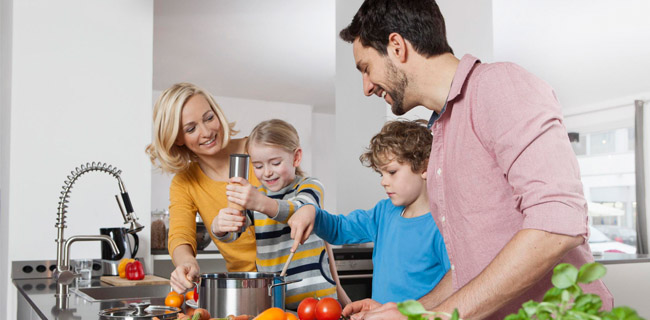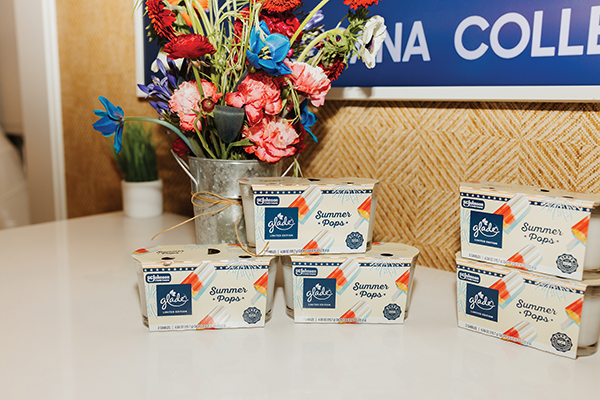Live Better
Swap these four food fads with nutritious kitchen staples

(BPT) – With new so-called “healthy” food trends popping up all the time, it’s hard to keep track of what’s actually good for your health and what’s just a fad. Luckily, new research continually shows consumers which fads to ditch and which kitchen staples stand the test of time and should be kept in our diets. For example, did you know that coconut oil, a recent consumer favorite in health and beauty circles, has been found in a new study to increase cholesterol?
If you are looking for simple changes that have a big impact on nutritional health, consider clearing some unhealthy eating habits from your diet. Here are a few health fads that aren’t as nutritious as you may have heard, and helpful swaps that can benefit your health.
Cooking with coconut oil
Over the last few years, coconut oil has gained prominence on grocery store shelves, in the news and on social media. Long considered a multipurpose beauty oil, coconut oil began to make its way into recipes, and consumers hoped its health benefits extended to the kitchen. However, a recent study has found that coconut oil increases cholesterol. Adding corn oil to one’s diet, on the other hand, was found by the study to result in better cholesterol levels compared with coconut oil. Similarly, a previous study published in The Journal of Clinical Lipidology found that corn oil can help lower cholesterol two times more than extra virgin olive oil. With a high smoke point, versatile usage and a neutral flavor, corn oil makes a great staple for any pantry.
Juice diets and cleanses
While it’s important to include fruits and vegetables in your diet, “cleansing” your body with a diet limited to cold-pressed juices won’t provide enough essential vitamins and minerals for a healthy diet. According to research by the National Center for Complementary and Integrative Health, there is no real evidence that juice cleanses work. The human body is great at keeping the good stuff in and filtering out the bad, and a varied diet is important for maintaining energy throughout the day. Plus, according to Vive Nutrition, juice diets tend to make people feel hungrier and lead to overeating. If cold-pressed juices are something you enjoy, go ahead and include them in addition to your meals.
Skipping dessert
Everything in moderation! Indulging every once in a while is an important part of a balanced diet. Harsh dietary restrictions, especially on the foods you love, may lead to short-term results, but aren’t sustainable in the long run, according to research by the National Center for Biotechnology Information. Rather than cutting sugar completely, avoid binges by allowing yourself a treat every once in a while on a cheat day to maintain balance in your diet.
Snacking on granola bars
Packed with whole grains, granola bars seem like the perfect healthy snack, but many contain an unhealthy amount of added sugar, which creates a caloric and less-than-nutritious food choice. In fact, according to a survey in the New York Times, less than 30 percent of nutritionists would call granola a healthy food. Replacing granola bars with healthier options like whole nuts will greatly benefit your health. This snack choice is less sugary, more filling and full of omega-3 fatty acids, which are shown to reduce the risk of chronic diseases.
With contradicting information about health coming out daily, it’s important to research the facts to learn which tips are fads and which are truly good for you. By making these diet swaps that benefit your body, you can start the year as your healthiest self ever.
Live Better
Choose play every day: How to transform every day activities into playful learning

(Family Features) Play is a universal language spoken by people of all ages. Through play, children learn to forge connections with others, build a wide range of leadership skills, develop resilience, conquer fears and navigate relationships and social challenges.
For babies and toddlers, play is about far more than just having fun; it’s about learning and building important skills, from cognitive and physical to emotional and social abilities. As children get older, play helps reduce stress levels, process difficult emotions, promote problem-solving and build confidence – skills they need to thrive in a rapidly changing world.
Despite its importance, play is often undervalued and overlooked due to busy schedules, lack of resources or misconceptions about its benefits. Approximately 4 in 10 children ages 2-4 do not get enough responsive interaction or stimulation at home, based on estimates from UNICEF, and roughly 1 in 8 children under age 5 don’t have toys or playthings at home.
To overcome these barriers, it’s essential for parents and caregivers to recognize the value of both structured and unstructured play. Simple, everyday items – like kitchen utensils, cardboard boxes, leaves and stones – can be tools for imaginative play. Setting aside dedicated time for play, even in short intervals, can make a difference.

In honor of International Day of Play, consider these ideas to turn everyday activities into playful learning opportunities from UNICEF, which recognizes play as an important means to help children by providing access to evidence-based parenting programs and working with governments to prioritize play-based teaching and learning practices in schools and other learning environments.
- Turn a grocery shopping trip into a scavenger hunt to teach kids about different foods, counting and categorization.
- Role play or act out different scenarios you read in books or see in movies to help develop social skills and emotional understanding.
- Make important language connections when getting dressed, such as identifying different articles of clothing and teaching colors.
- Use bathtime to explore buoyancy and water with floating toys.
- Play “I spy” while driving in the car or going for a walk around your neighborhood to help kids identify different animals, shapes, colors and elements of nature like trees, clouds and more.
- Explore the kitchen through tasks such as choosing ingredients, measuring them and keeping time while cooking.
- Use puzzles and building blocks to help develop problem-solving skills and hand-eye coordination.
- Stimulate senses and promote fine motor skills through play with materials like sand, water or crafting dough.
- Make sorting laundry educational by asking children to match socks by color or size, reinforcing their understanding of sorting and categorization.
- Take turns doing the feeding at snack or mealtimes to build hand-eye coordination.
Find more ways to engage your children in fun, engaging play at unicefusa.org/play.
SOURCE:
Live Better
Laying the foundation for writing

(Family Features) Learning to write is one of the defining milestones of early childhood, but it doesn’t happen all at once. Children build writing skills over time, from indecipherable scribbles to writing letters and words. While children progress at their own pace, families can help foster early writing development.
Dr. Lauren Loquasto, senior vice president and chief academic officer at The Goddard School, and Dr. Sonia Cabell, professor of reading education at Florida State University and member of The Goddard School’s Educational Advisory Board, provide this insight and guidance for families.
Early Writing Milestones
Writing begins in early toddlerhood, around 18-24 months. The earliest developmental milestone is when children scribble on paper with a crayon.
By 2-3 years old, children often draw shapes and narrate their writing. Parents should show genuine interest to help build confidence and interest. Ask your children to read what they write, as this helps make the connection that marks on paper represent thoughts and ideas. It’s not expected for children younger than 3 to write identifiable letters. Instead, encourage them to make marks on paper without constraint, allowing them to freely express themselves.
Around ages 3-5, children begin to move from writing (making marks) to handwriting, which is the formalized motion of making numerals and letters in recognizable forms. It’s vital for parents to value their children’s writing no matter what appears on the paper and provide opportunities for them to regularly engage in writing. Children at this age tend to write letters in different ways. It’s common, for example, for letters to appear backwards or from right to left. These are not causes for concern; this is a natural part of the development process.
Writing Supports Reading (and Vice Versa)
Reading and writing skills develop in tandem, reinforcing each other. Through writing, children experiment with how written language works, learning English moves from left to right and top to bottom. By estimating spelling – using their knowledge of letter shapes and sounds to attempt to write words – they are beginning to break the code of reading. Moreover, when children are composing stories, they are supporting comprehension and oral language growth, which are critical for reading development.

Encourage Writing at Home
Make writing part of everyday life. While ensuring paper and writing utensils are accessible is a start, materials alone won’t spontaneously create writing experiences. Children naturally want to engage with things they see, so parents and older siblings should serve as writing models. For example, when writing a grocery list, ask your children to write their own lists. When you’re writing a thank-you note, have them write their own.
The development of fine motor skills is also essential. One way to do this is provide tools like chopsticks or tongs that require them to use their forefinger and thumb in a pinching motion; this strengthens the hand muscles that are used to write. Also encourage play with small toys like blocks or beads that engage the hands in different ways. As fine motor skills improve, it becomes easier to grip writing utensils and write for extended periods.
Writing Tools
From apps to workbooks, countless tools and resources tout their ability to help children learn to write. Be wary. Typing on a tablet or computer is no substitute for learning to write by hand. Multiple studies have shown that writing – not typing – better promotes cognitive and literacy development.
Avoid activities like workbooks that require repetitive writing of letters over and over, as this inhibits creativity and experimentation. These activities can cause children to fear making mistakes, which can lead to anxiety, frustration and a loss of interest. The best tools are often the simplest: a small writing utensil (not big or bulky; children have small hands and need appropriately sized utensils) and a blank piece of paper.
Remember, children develop at their own pace. Provide encouragement and focus on effort, not perfection.
To watch a writing webinar featuring Loquasto and Cabell and access additional parenting resources, visit the Parent Resource Center at GoddardSchool.com.
Photos courtesy of Shutterstock
SOURCE:
Live Better
Keep your summer entertaining simple, fun

5 expert ways to make the most of seasonal gatherings
(Family Features) From summer holidays and pool parties to spontaneous backyard barbecues with friends and neighbors, the hottest season of the year brings people together. When it’s your turn to host, make the most of the occasion by setting up your space to maximize the fun while showing off your festive side.
“Summer is hands down my favorite time to host,” said Kristina Zias, lifestyle, beauty and fashion expert and mom. “I love any excuse to bring people together and – let’s be real – I’m always looking for a reason to throw a party. The key is keeping things low stress for the host and making sure guests feel comfortable the second they walk in.”
This season, Zias and Glade are teaming up to share some of her favorite summer entertaining tips, which are simple, low-effort ways to make every gathering feel special. Whether you’re planning a full-blown backyard bash or hosting a few friends for drinks, Zias’ go-to ideas are all about setting the mood and enjoying the moment.
1. Set the Scene Without the Stress
To achieve a beautiful scene and make cleanup a breeze, try using disposable plates, utensils, napkins and cups in red, white and blue. A self-serve drink station with strawberry-infused water and a table of colorful fruit skewers adds charm without requiring much prep.

2. Tap Into Nostalgia Through Scent
Scent can instantly transport guests back to cherished summer memories, making it a powerful way to set the tone and spark conversation. Zias suggests using home fragrances to do just that. The new Glade Americana collection, available exclusively in stores and online at Walmart, features three limited-edition scents inspired by nostalgic summer traditions like beach trips, ice pops and garden-fresh fruit. Masterfully crafted to help bring summer to every room of your home, they’re designed to evoke warm-weather traditions.
- Berries & Cream: Scents of a classic American summer treat spring to life in a picnic-perfect blend of apple, red berries, apricot, vanilla and sweet cream.
- Summer Pops: Reminisce on childhood memories of a cool ice pop on a warm summer day with bright notes of Brazilian orange, pineapple, strawberry, white peach and sandalwood.
- Beach Life: Transport yourself to a favorite summer vacation spot by the ocean with a breezy mix of sea salt, driftwood, white moss and white peony.
“These seasonal scents can help you evoke nostalgic memories and bring that summer energy into any room of your home,” Zias said. “They make everything feel a little more special and, honestly, they just make me happy.”
3. Keep It Simple and Guest-Friendly
Part of summer’s appeal is its easygoing vibe, so there’s no need to overdo it with complicated snacks or overwhelming decor. Lean into the simplicity of the season with ready-to-serve bites that can please guests of all ages, like berries, sliced or cubed watermelon, meat and cheese trays, sliders or chips and light dips. A separate kids station with games and snacks can keep little ones entertained.
4. Create Comfortable Hangout Spots
The hot summer sun and cool indoor air means guests will likely filter in and out of the house, so help them feel welcome and comfortable wherever they may be. Consider flexible seating guests can move around on the patio or in the yard, like bag chairs or foldable lawn chairs. Complement your festive indoor drink station with beverage-filled coolers to keep guests refreshed and designate an area for essentials like sunscreen and bug spray.
5. Have a Backup Plan
The best-laid plans can go awry when summer storms pop up. Before inviting the entire town for a barbecue, make sure you have enough indoor space and seating in case of rain or extreme heat. For grilling plans, Zias recommends prepping an alternate cooking method to avoid last-minute stress. A little backup planning can help keep the good vibes going, rain or shine.
For more summer entertaining ideas, visit Glade.com.
Photo courtesy of Shutterstock (group of friends eating)
Photo courtesy of Glade (candles)
SOURCE:
-

 NEWS2 years ago
NEWS2 years agoSuspect indicted, jailed in Tia Hutson murder
-

 NEWS3 years ago
NEWS3 years ago2 hurt, 1 jailed after shooting incident north of Nocona
-

 NEWS2 years ago
NEWS2 years agoSO investigating possible murder/suicide
-

 NEWS3 years ago
NEWS3 years agoWreck takes the life of BHS teen, 16
-

 NEWS2 years ago
NEWS2 years agoMurder unsolved – 1 year later Tia Hutson’s family angry, frustrated with no arrest
-

 NEWS2 years ago
NEWS2 years agoSheriff’s office called out to infant’s death
-

 NEWS2 years ago
NEWS2 years agoBowie Police face three-hour standoff after possible domestic fight
-

 NEWS3 years ago
NEWS3 years agoDriver stopped by a man running into the street, robbed at knifepoint






